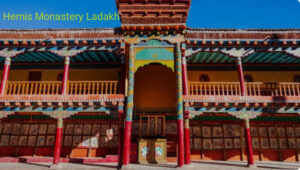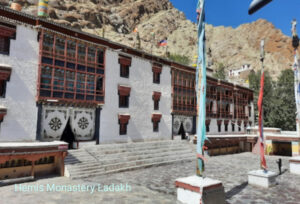Nestled in the breathtaking landscape of Ladakh, Hemis Monastery Ladakh, stands as a testament to the region’s rich spiritual and cultural heritage. As one of the largest and most significant monasteries in Ladakh, Hemis Monastery is a must-visit destination for travelers seeking to explore the spiritual essence of the Himalayas. This ancient monastery, with its awe-inspiring architecture, vibrant festivals, and deep-rooted spiritual significance, offers a unique glimpse into the heart of Tibetan Buddhism.

1. Hemis Monastery Ladakh: Historical Background
Hemis Monastery, also known as Hemis Gompa, was founded in the 17th century during the reign of King Sengge Namgyal. This revered king played a pivotal role in establishing the monastery, which became a key center for the Drukpa lineage of Tibetan Buddhism. The monastery’s historical significance extends beyond its religious importance; it also served as a hub for spiritual learning and a beacon of Ladakh’s cultural identity.
The origins of Hemis Monastery are deeply intertwined with the spread of Buddhism in the region. Over the centuries, it has been a focal point for religious scholars, monks, and practitioners who sought to deepen their understanding of Buddhist teachings. The monastery’s rich history is preserved through its ancient manuscripts, relics, and artifacts that continue to draw the attention of historians and devotees alike.
2.Hemis Monastery Ladakh: Architectural Splendor
The architectural grandeur of Hemis Monastery is a sight to behold. Situated against the backdrop of rugged mountains, the monastery’s design reflects the traditional Tibetan style, characterized by its whitewashed walls, wooden balconies, and intricately carved windows. The monastery complex includes several important structures, each with its own unique significance.
The main assembly hall, known as the Du khang, is the spiritual heart of the monastery. Adorned with vibrant murals and thangkas (religious paintings), the Du khang is where monks gather for prayer and meditation. The temple, or T shog khang, houses the monastery’s most revered statue—a giant figure of Guru Padmasambhava, also known as the “Second Buddha.” This statue, a masterpiece of Tibetan art, symbolizes the spiritual power and protection that Guru Padmasambhava provides to the region.
One of the most remarkable features of Hemis Monastery is its collection of ancient thangkas. These sacred paintings depict various deities, mandalas, and scenes from Buddhist mythology, serving both as objects of worship and as teaching tools. The monastery’s walls are also adorned with intricate murals that narrate the life and teachings of Buddha, offering visitors a visual journey through Buddhist history.
3. The Hemis Festival
The Hemis Festival, also known as Hemis Tsechu, is one of the most vibrant and widely celebrated events in Ladakh. Held annually in the monastery’s courtyard, this festival commemorates the birth anniversary of Guru Padmasambhava. The highlight of the festival is the Cham dance, a traditional masked dance performed by monks. These dances, accompanied by the sounds of cymbals, drums, and horns, are not just a form of entertainment but a powerful expression of Buddhist philosophy.
The Hemis Festival attracts thousands of visitors, including tourists, pilgrims, and locals, who come to witness the colorful spectacle. The festival is also an opportunity for devotees to receive blessings and participate in rituals that have been passed down through generations. The grandeur of the festival, with its vibrant costumes, elaborate masks, and sacred rituals, makes it a unique cultural experience that encapsulates the spirit of Ladakh.

4.Spiritual and Cultural Importance
Beyond its architectural beauty and festivals, Hemis Monastery holds deep spiritual and cultural significance. It has long been a center for Buddhist learning, where monks engage in rigorous study and meditation. The monastery’s library houses a vast collection of ancient texts and scriptures, many of which are rare and invaluable. These texts are not only important for religious study but also for preserving the region’s cultural heritage.
Hemis Monastery’s influence extends to the local community, where it plays a crucial role in maintaining the traditions and practices of Tibetan Buddhism. The monastery’s teachings emphasize compassion, mindfulness, and the pursuit of enlightenment—principles that resonate deeply with the people of Ladakh. The monastery also serves as a sanctuary for those seeking spiritual solace, offering retreats and meditation sessions for visitors.
5.Visiting Hemis Monastery
A visit to Hemis Monastery is an unforgettable experience that allows travelers to immerse themselves in the spiritual ambiance of Ladakh. The best time to visit the monastery is during the summer months, particularly in June or July, when the Hemis Festival takes place. This period offers the perfect opportunity to witness the monastery’s cultural vibrancy and enjoy the scenic beauty of Ladakh.
Hemis Monastery is located approximately 45 kilometers from Leh, the capital of Ladakh. The journey to the monastery is an adventure in itself, with winding roads that offer panoramic views of the surrounding mountains and valleys. Visitors can easily reach the monastery by road, either by hiring a taxi or taking a bus from Leh. The nearby attractions, such as the Thiksey Monastery, Shey Palace, and Stok Palace, make the trip even more worthwhile.
6. Conservation and Preservation Efforts
Preserving the rich heritage of Hemis Monastery is a priority for both the government and the local community. Efforts have been made to maintain the monastery’s structures and protect its valuable artifacts from the harsh weather conditions of Ladakh. Additionally, there is a growing emphasis on promoting sustainable tourism, ensuring that the influx of visitors does not negatively impact the monastery’s environment and cultural integrity.
Challenges such as climate change and increased tourism have posed threats to the monastery’s preservation. However, initiatives to restore and conserve the monastery are ongoing, with the involvement of both national and international organizations. These efforts are crucial for safeguarding the monastery’s legacy for future generations and for maintaining its role as a spiritual and cultural beacon in Ladakh.
Conclusion:
Hemis Monastery is not just a place of worship; it is a symbol of Ladakh’s rich cultural and spiritual heritage. From its stunning architecture to its vibrant festivals, the monastery offers a unique window into the world of Tibetan Buddhism. For those seeking a deeper connection with the spiritual traditions of the Himalayas, a visit to Hemis Monastery is an experience that leaves a lasting impression.
In the serene atmosphere of Hemis, surrounded by the towering peaks of Ladakh, visitors can find peace, inspiration, and a profound sense of connection to a centuries-old tradition that continues to thrive in this remote corner of the world.
FAQ:
1.Why is Hemis Monastery famous?
2.Who is the head lama of Hemis monastery?
3.In which district is Hemis monastery?
4.What is thiksey monastery Ladakh famous for?
5.Hemis Monastery official website
6.Hemis Monastery stay
7.Hemis Monastery photos

